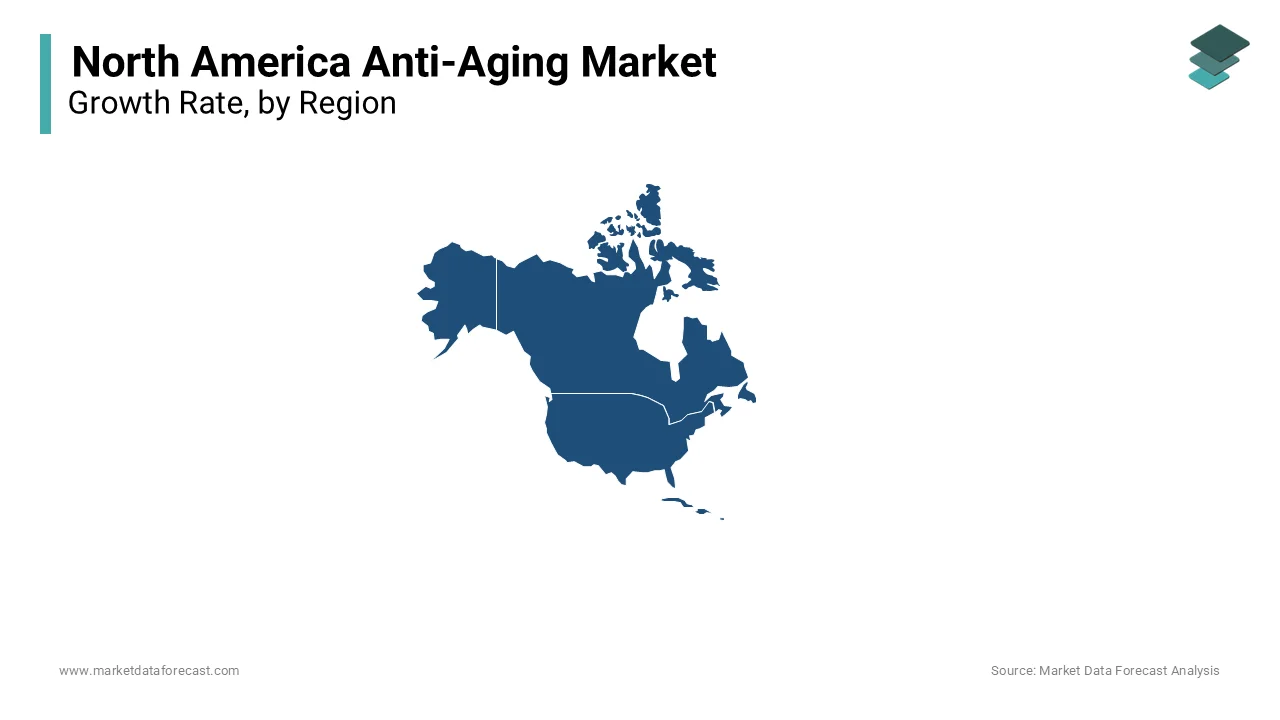North America Anti-Aging Market Size, Share, Trends & Growth Forecast Report By Demographics Products Type, Services, Devices Type and Country (United States, Canada & Rest of the North America), Industry Analysis From 2024 to 2033
North America Anti-Aging Market Size
The North American anti-aging market was valued at USD 19.29 billion in 2024 and is expected to reach USD 30.39 billion by 2033 from USD 20.24 billion in 2025, growing at a compound annual growth rate (CAGR) of 5.21 % during the forecast period.

MARKET DRIVERS
North America is the most promising regional segment in the global anti-aging market and accounts for the majority of the worldwide market share. In the North American anti-aging market, increasing consumer awareness is a significant factor. As the population increases, there is a growing consciousness about the signs of aging, such as wrinkles, fine lines, and skin imperfections. This awareness is supported by various factors, like the influence of social media, where youthful images are highly emphasized. Consumers are becoming increasingly knowledgeable about the advantages of anti-aging solutions. This heightened awareness is primarily driven by the easy access to information and the abundance of testimonials available and it has also created a robust market for anti-aging innovations, with individuals actively investing in strategies to enhance both their appearance and overall well-being.
The North American anti-aging market is thriving in response to technological advancements. These advancements assure a broader spectrum of solutions, ranging from non-invasive procedures to cutting-edge skincare products and regenerative medicine, all designed to help individuals maintain a youthful and good appearance. Non-invasive procedures like Botox injections, dermal fillers, and laser therapies have gained immense popularity, offering effective and relatively low-risk options to address wrinkles, fine lines and skin irregularities. These treatments provide immediate results in less time and are appealing to consumers who seek quick and efficient solutions. Additionally, the anti-aging market has seen substantial growth in advanced skincare products because of high technology advancements. These formulations target specific signs of aging and offer consumers accessible options for daily use. Overall, technological progress continues to shape the North American anti-aging market, offering an expanding array of choices for individuals looking to maintain their youthfulness and vitality.
MARKET RESTRAINTS
Cost and pricing dynamics pose a significant restraint In the North American anti-aging market. The pursuit of a youthful appearance often comes with a substantial price tag, which can deter a significant portion of the population, especially those without access to health insurance coverage or adequate financial resources. Advanced medical procedures can be particularly expensive. These costs are not limited to the initial procedure but also include maintenance and follow-up appointments. Additionally, high-quality anti-aging skincare products and regimens, which can yield gradual results, may require ongoing investments. The affordability barrier may result in limiting the ability of some individuals to explore these options, which can cause the downfall of the market.
REGIONAL ANALYSIS
North America dominates the anti-aging market due to its large aging population, high consumer awareness, strong emphasis on physical appearance, advanced medical technologies, and relatively lenient regulatory frameworks.

The United States holds the largest share of the market because of its significantly large population, consumer awareness, and advanced healthcare infrastructure. The US market is known for a high demand for both non-invasive cosmetic treatments and anti-aging skincare products. The regulatory environment in the US ensures that consumers have access to safe and effective anti-aging solutions by contributing best to the market growth. Additionally, the US also leads high in technological advancements and clinical research, which caused the continuous innovation of new treatments and products.
Canada's anti-aging market is also growing nicely, as it is driven by a large population, which increases consumer awareness of anti-aging solutions. Consumers in Canada started to prioritize natural and organic approaches to anti-aging, emphasizing overall health and well-being alongside external appearance. Access to anti-aging services may be limited in more remote areas, with urban centers having a greater concentration of offerings. As in the US, the Canadian market is also experiencing a shift towards online retail channels, especially in response to the COVID-19 pandemic.
KEY MARKET PLAYERS
Some of the major players in the North American anti-aging market profiled in this report include Coty Inc., Personal Microderm, Beiersdorf AG, Photomedex Inc., Lumenis Ltd, Alma Lasers Ltd., Solta Medical Inc., Cynosure Inc., L’Oreal, SA, and Allergan Inc.
MARKET SEGMENTATION
This research report on the North American anti-aging market has been segmented and sub-segmented based on the following categories.
By Demographics
- Baby Boomers
- Generation X
- Generation Y
By Product Type
- UV Absorbers
- Anti-Wrinkle Products
- Anti-Stretch Marks Products
- Natural Products
- Hair Colour
By Services
- Anti-Pigmentation Therapy
- Adult Acne Therapy
- Breast Augmentation
- Liposuction Services
- Abdominoplasty
- Chemical Peel
- Eye-Lid Surgery
- Hair Restoration
- Sclerotherapy
By Devices
- Anti-Cellulite Treatment Devices
- Microderm Abrasion Devices
- Laser Aesthetic Devices
- Radiofrequency Devices
By Country
- The U.S.
- Canada
- Rest of North America
Related Reports
Access the study in MULTIPLE FORMATS
Purchase options starting from $ 2000
Didn’t find what you’re looking for?
TALK TO OUR ANALYST TEAM
Need something within your budget?
NO WORRIES! WE GOT YOU COVERED!
Call us on: +1 888 702 9696 (U.S Toll Free)
Write to us: [email protected]
